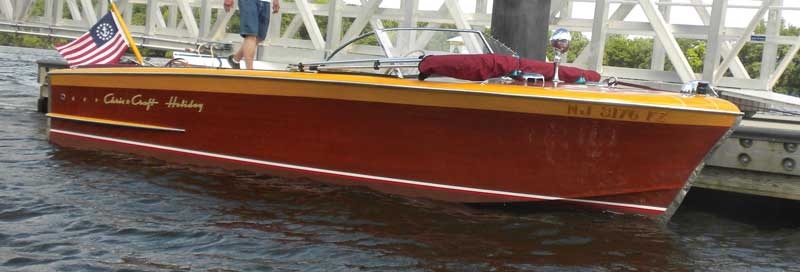Liquid Asset is a 19-foot Chris-Craft Holiday built in 1951. She is a spirited classic runabout!

She shone in the sun along the floating pier with a reflection that probably beat out the level of finish that Chris-Craft applied when she was built in 1951. Liquid Asset was completing her in-water test following a light yet complete refinish at Planks & Power Boat Restoration in Wantage, NJ.
I had a chance to experience her ride on the Antique & Classic Boat Society’s Delaware River cruise. I was invited aboard by Ed Andrews, the boat’s owner and president of the ACBS Mid-Atlantic Chapter.
The Philadelphia and Barnegat Bay ACBS Chapters merged and were re-named the Mid-Atlantic Chapter. The group hosts events in New Jersey, Pennsylvania, New York, and Florida throughout the year. Many of its members also participate in the annual classic boat festival hosted in St Michaels, MD, by the Chesapeake Bay chapter.
Ed was eager to become the second owner of this runabout when he purchased it in 1992. The seller was the original owner who bought it brand new from Chris-Craft.
Ed’s family owned a 21-foot Holiday when he was growing up. That boat played a major role in his life, whether he was helping with the regular maintenance projects each spring or enjoying the summer on the water.
Once we were on the main river, Liquid Asset all but leaped on plane after she was given some throttle. She handled the small chop from the wind with ease. Turns to the right or left yielded a nice, sharp response for each change in direction with that comfortable small transom slide that a good classic speedboat enjoys.
Liquid Asset is Chris-Craft hull number H-19-027. The “H” refers to the Holiday model name, “19” represents her 19-foot length, and the “27” confirms that she’s the 27th boat of this model built that year. By the way, this 19-foot Holiday model’s length was new in 1951. Ed’s runabout was one of the 107 Holiday models produced that year. There was also a 23-foot model that was new for 1951. At the time, Holiday models were offered in 19-, 21-, and 23-foot lengths.
In the off-seasons of 2017 and 2018, Liquid Asset’s 12-hp six-cylinder Chris-Craft engine was rebuilt and beautifully detailed by Van Ness Engineering of New Jersey at the same time that the hull and deck work of this last major restoration was being done in Katz’s Marina in Andover, NJ. This was the third restoration in the boat’s history. The first was by the prior owner, the second by a shop in the Adirondacks (now out of business).
Chris-Craft’s entire production in 1951 generated sales exceeding $17,000,000, with about $850,000 in profit. That was certainly a healthy balance sheet since Chris-Craft had already paid $600,000 in capital stock during that fiscal year to Hercules, its major engine block and long block manufacturing source.
Chris-Craft’s Winning Race Hulls
Joseph Napoleon Lisee (nicknamed “Nap”) was the main hull designer behind Chris-Craft’s race-winning days. He was born in 1891 and died in 1946. Nap started working for Chris Smith in 1905. He designed Smith’s 1916 successful Gold Cup raceboat, Miss Detroit.
Gar Wood bought Miss Detroit from Chris Smith for $1000 cash along with an $800 note. Soon after, Gar Wood also bought a controlling interest in the C. C. Smith Boat & Engine Company, which we now call Chris-Craft. “Nap” as well as Chris’s sons, Jay and Bernard, joined with a percentage ownership interest in the company.
“Nap” designed another racer (Miss Detroit II) to use the 250-hp engine from the remains of the original Miss Detroit boat. Miss Detroit II set a speed record of 61.724 mph. Chris Smith’s son Jay was aboard as the riding mechanic when the record was set. All the Miss America hulls were a “Nap” design, including Miss America X, which set a record of over 124.42 mph.
Gar Wood hired “Nap” to design the hull of the famous “Baby Gars.” They were built on a 33-foot-long triple cockpit layout that came on the market in 1922 and were the cream of the crop in luxury runabouts. A shorter, 28-foot Baby Gar was introduced in 1927.
By Chris “Seabuddy” Brown